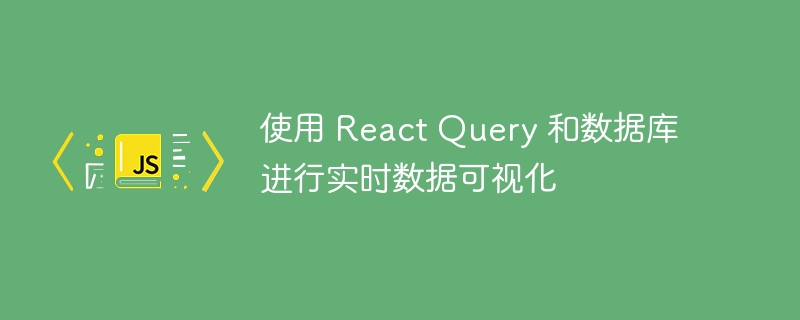

Title: Real-time data visualization using React Query and database
Introduction:
In modern website and application development, real-time data visualization is a very important important features. It enables users to monitor and analyze data in real time and make decisions accordingly. In this article, we will introduce how to use React Query and a database to achieve real-time data visualization, and give specific code examples.
1. Introduction to React Query
React Query is a library that provides data capture, sharing and synchronization for React applications. It can easily handle front-end data management, including fetching data from servers, caching data, synchronizing data, and updating it in real time as needed. React Query makes the flow of data through your application very simple and efficient.
2. Database selection
In real-time data visualization, the database is the core part of storing and managing data. Depending on the specific needs and project requirements, we can select the appropriate database. Here are a few commonly used database options:
Select an appropriate database based on specific project needs and ensure it has good performance and reliability.
3. Use React Query to obtain data
In real-time data visualization, you first need to obtain data from the database. Fetching data from the server is easy using React Query’s useQuery hook. The following is a sample code to obtain data:
import { useQuery } from 'react-query';
function DataVisualization() {
const { data, isLoading, error } = useQuery('data', () => {
// 发起数据请求的逻辑
return fetch('http://example.com/data').then(res => res.json());
});
if (isLoading) {
return <div>Loading...</div>;
}
if (error) {
return <div>Error: {error.message}</div>;
}
// 进行数据可视化的逻辑
return <div>{/* 在此处进行数据可视化 */}</div>;
}In the above code, we use the useQuery hook to initiate a data request and handle the status of data loading and loading errors. Depending on the specific situation, the logic of the data request can be adjusted to ensure that the data can be obtained correctly.
4. Update data in real time
In real-time data visualization, the data needs to be updated in real time so that users can see the latest data changes. Use React Query's useMutation hook to update and synchronize data. The following is a sample code that updates data in real time:
import { useQuery, useMutation, queryCache } from 'react-query';
function DataVisualization() {
const { data } = useQuery('data', () => {
return fetch('http://example.com/data').then(res => res.json());
});
const updateData = useMutation((newData) => {
return fetch('http://example.com/update', {
method: 'POST',
body: JSON.stringify(newData),
}).then(res => res.json());
}, {
onSuccess: () => {
queryCache.invalidateQueries('data');
},
});
const handleUpdate = () => {
const newData = // 获取新的数据
updateData.mutate(newData);
};
return (
<div>
{/* 数据可视化的逻辑 */}
<button onClick={handleUpdate}>更新数据</button>
</div>
);
}In the above code, we use the useMutation hook to update the data, and notify React Query that the data has been updated through the onSuccess callback function. When the "Update Data" button is clicked, the handleUpdate function is called to trigger the data update logic.
5. Real-time data visualization
On the basis of obtaining and updating data, we can use common data visualization libraries (such as D3.js, Chart.js, etc.) to achieve real-time data visualization. The specific implementation is closely related to the data visualization library chosen and is beyond the scope of this article.
Summary:
Using React Query and a database, we can easily achieve real-time data visualization. In this article, we introduce how to use React Query to obtain data and update data in real time, and give specific code examples. I hope this article can be helpful to you in your real-time data visualization project.
The above is the detailed content of Real-time data visualization using React Query and database. For more information, please follow other related articles on the PHP Chinese website!




